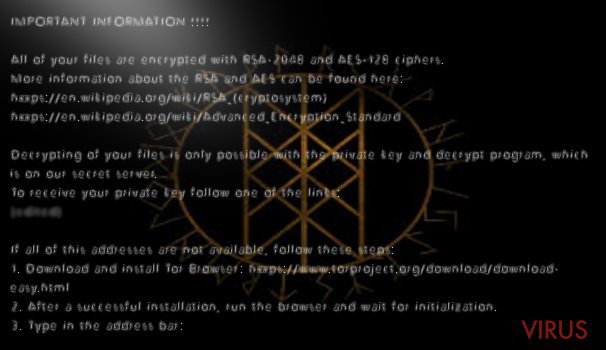Uninstall ODIN virus (Clear Removal Instructions)
ODIN virus Removal Guide
Description of ODIN ransomware virus
Everything you should know about ODIN ransomware
ODIN virus is the second and latest version of the Locky ransomware. The virus mostly targets U.S. users; however, there’s no doubt that ransomware is going to grow and spread all over the world. The main characteristics of ODIN malware are similar to other ransomware infections. It mostly spreads via malicious email campaigns, encrypts files using strong algorithms and tries to swindle the money from the victims. The only difference is that virus appends .odin file extension to corrupted files and changes entire file name. After successful encryption, it changes the background of the infected computer with a ransom message. Hackers try to scare you, but you should not give. Instead of considering paying the ransom, you have to initiate ODIN removal. FortectIntego might be a handy tool for eliminating this dangerous virus.
ODIN ransomware uses RSA-2048 and AES-CBC 256 techniques to encrypt files and appends .odin file extension. Besides, it changes file names entirely by creating a new name from random letters and numbers. The virus makes user’s data useless. However, hackers leave an opportunity to get back access to corrupted data. After hijack malware leaves ransom notes on the desktop: _HOWDO_text.html, _HOWDO_text.bmp, and _[2_digit_number]_HOWDO_text.html, where victims can find an explanation about file encryption and decryption. There’s no surprise that victims have to purchase a decryption key for restoring lost data. Even though paying the ransom might seem like the only possible option, you should know that hackers are not worth trusting. After receiving your payment, hackers can simply disappear. Of course, there’s a possibility that they provide you a decryption key or some software for restoring the files. The problem is that you might get additional malware with restored data. We do not recommend paying the ransom. You have to remove ODIN from your PC first and only then think about other ways to retrieve locked files. For example, you can easily restore your file from backups.

Tips for protecting computer from ransomware attack
ODIN hijack usually happens when victims open an infected email attachment. Once victims open the file, the malicious script is executed, and it starts scanning the computer. As you already know, the result of the scan is encrypted files. If you want to avoid this unpleasant activity, you should be careful with your emails. Do not open spam emails, questionable attachments and pay attention to the sender. Is he or she familiar to you? If you receive an email from a particular institution, make sure that the sender actually works there. Double checking the information is just one of many tips to protect your computer. Malware can enter your PC via exploit kits as well, so you should stay away from file-sharing services and use only reliable sources for software downloads and installation. Also, we recommend strengthening your computer’s security by installing a professional anti-malware program. However, you cannot expect that security programs protect your PC 100%. Your actions online should be measured too.
Guidelines for ODIN removal
ODIN malware is a dangerous type of computer infections, so you should take its removal seriously. Do not consider removing the virus manually! Only experienced virus researchers might be capable of eliminating the virus without any help. Ordinary computer users have to employ professional anti-malware tools in order to remove ODIN. If your computer is protected with a security program, you have to update it before starting virus elimination. If you don’t use any anti-malware program, we recommend one of these programs FortectIntego, SpyHunter 5Combo Cleaner or Malwarebytes. Sometimes ransomware blocks antivirus programs and prevents from updating them or scanning the system. If you encounter this problem, please follow our instructions bellow. There we will explain how to access or install malware removal tools.
After ODIN removal you can think about recovering encrypted files. If you have backup copies, you can restore files from them. Actually, all computer users should back up their files regularly in case of ransomware attack or other computer problem. However, if you don’t have backups, at the end of the article you will find ways how to decrypt your data.
Getting rid of ODIN virus. Follow these steps
In-depth guide for the ODIN elimination
Important! →
The elimination guide can appear too difficult if you are not tech-savvy. It requires some knowledge of computer processes since it includes system changes that need to be performed correctly. You need to take steps carefully and follow the guide avoiding any issues created due to improper setting changes. Automatic methods might suit you better if you find the guide too difficult.
Step 1. Launch Safe Mode with Networking
Safe Mode environment offers better results of manual virus removal
Windows 7 / Vista / XP
- Go to Start.
- Choose Shutdown, then Restart, and OK.
- When your computer boots, start pressing the F8 button (if that does not work, try F2, F12, Del, etc. – it all depends on your motherboard model) a few times until you see the Advanced Boot Options window.
- Select Safe Mode with Networking from the list.

Windows 10 / Windows 8
- Right-click the Start button and choose Settings.

- Scroll down to find Update & Security.

- On the left, pick Recovery.
- Scroll to find Advanced Startup section.
- Click Restart now.

- Choose Troubleshoot.

- Go to Advanced options.

- Select Startup Settings.

- Press Restart.

- Choose 5) Enable Safe Mode with Networking.
Step 2. End questionable processes
You can rely on Windows Task Manager that finds all the random processes in the background. When the intruder is triggering any processes, you can shut them down:
- Press Ctrl + Shift + Esc keys to open Windows Task Manager.
- Click on More details.

- Scroll down to Background processes.
- Look for anything suspicious.
- Right-click and select Open file location.

- Go back to the Process tab, right-click and pick End Task.
- Delete the contents of the malicious folder.
Step 3. Check the program in Startup
- Press Ctrl + Shift + Esc on your keyboard again.
- Go to the Startup tab.
- Right-click on the suspicious app and pick Disable.

Step 4. Find and eliminate virus files
Data related to the infection can be hidden in various places. Follow the steps and you can find them:
- Type in Disk Cleanup in Windows search and press Enter.

- Select the drive (C: is your main drive by default and is likely to be the one that has malicious files in) you want to clean.
- Scroll through the Files to delete and select the following:
Temporary Internet Files
Downloads
Recycle Bin
Temporary files - Pick Clean up system files.

- You can also look for other malicious files hidden in the following folders (type these entries in Windows Search and press Enter):
%AppData%
%LocalAppData%
%ProgramData%
%WinDir%
After you are finished, reboot the PC in normal mode.
Eliminate ODIN using System Restore
-
Step 1: Restart your computer in Safe Mode with Command Prompt
Windows 7 / Vista / XP- Go to Start → Shutdown → Restart → OK.
- As soon as your computer starts, start pressing F8 key repeatedly before the Windows logo shows up.
-
Choose Command Prompt from the list

Windows 10 / Windows 8- Click on the Power button at the Windows login screen, and then press and hold Shift key on your keyboard. Then click Restart.
- Then select Troubleshoot → Advanced options → Startup Settings and click Restart.
-
Once your computer starts, select Enable Safe Mode with Command Prompt from the list of options in Startup Settings.

-
Step 2: Perform a system restore to recover files and settings
-
When the Command Prompt window appears, type in cd restore and press Enter.

-
Then type rstrui.exe and hit Enter..

-
In a new window that shows up, click the Next button and choose a restore point that was created before the infiltration of ODIN and then click on the Next button again.


-
To start system restore, click Yes.

-
When the Command Prompt window appears, type in cd restore and press Enter.
Bonus: Restore your files
Using the tutorial provided above you should be able to eliminate ODIN from the infected device. novirus.uk team has also prepared an in-depth data recovery guide which you will also find above.There are a couple of methods you can apply to recover data encrypted by ODIN:
Recover you files with Data Recovery Pro
Data Recovery Pro might be useful for recovering files encrypted by ODIN virus. This program was created for locating missing files and folder on the computer after system wreckage. However, you can try using this tool for restore your corrupted files.
- Download Data Recovery Pro;
- Install Data Recovery on your computer following the steps indicated in the software’s Setup;
- Run the program to scan your device for the data encrypted by ODIN ransomware;
- Recover the data.
Restore your files with System Recovery
This method allows accessing the previous version of the operating system before ransomware attack. Then, you will be able to copy necessary files. Follow these steps:
- Right-click on the encrypted document you want to recover;
- Click “Properties” and navigate to “Previous versions” tab;
- In the “Folder versions” section look for the available file copies. Choose the desired version and press “Restore”.
It is strongly recommended to take precautions and secure your computer from malware attacks. To protect your PC from ODIN and other dangerous viruses, you should install and keep a powerful malware removal tool, for instance, FortectIntego, SpyHunter 5Combo Cleaner or Malwarebytes.
How to prevent from getting ransomware
Prevent the government from spying on you
As there is a growing debate in government about collecting users' data and spying on citizens, you should take a closer look at this issue and find out what shady ways of gathering information can be used to collect information about you. You need to browse anonymously if you want to avoid any government-initiated spying and tracking of information.
You can enjoy secure internet browsing and minimize the risk of intrusion into your system if you use Private Internet Access VPN program. This VPN application creates a virtual private network and provides access to the required data without any content restrictions.
Control government and other third party access to your data and ensure safe web browsing. Even if you do not engage in illegal activities and trust your ISP, we recommend being careful about your security. You should take extra precautions and start using a VPN program.
Recover files damaged by a dangerous malware attack
Despite the fact that there are various circumstances that can cause data to be lost on a system, including accidental deletion, the most common reason people lose photos, documents, videos, and other important data is the infection of malware.
Some malicious programs can delete files and prevent the software from running smoothly. However, there is a greater threat from the dangerous viruses that can encrypt documents, system files, and images. Ransomware-type viruses focus on encrypting data and restricting users’ access to files, so you can permanently lose personal data when you download such a virus to your computer.
The ability to unlock encrypted files is very limited, but some programs have a data recovery feature. In some cases, the Data Recovery Pro program can help recover at least some of the data that has been locked by a virus or other cyber infection.







